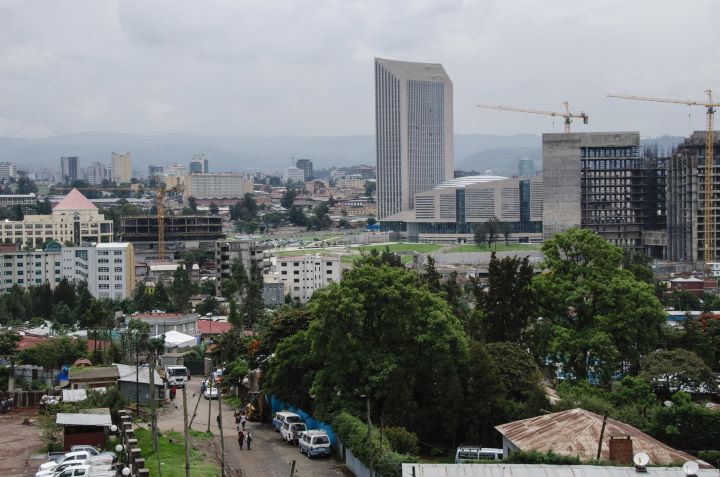May 25 is "Africa Day"... Dear Japanese friends, do you know it?
2024.05.24
-

- Yoshizawa Kei Planning and TICAD Process Division Africa Department
When you search for "May 25" on the Internet, you will find various titles of commemorative days such as "Cafeteria Car Day," "Kojien (the most popular Japanese dictionary) Memorial Day," "Housewives' Holiday Day," "Protected Cat Day," etc. Above them, Wikipedia proudly lists "Africa Day" at the top of the list, regrettably, which is not so broadly known in Japan.
May 25 is designated as "Africa Day" to commemorate the decision to establish the Organization of African Unity (OAU, the predecessor of the current African Union (AU)) by 30 African independent nations on May 25, 1963. As its name expressed, OAU was established to “unify” Africa. However, Africa is currently divided into 54 countries[1], bothering many of Japanese people trying to find which country is where on a map.
In textbooks on world history and geography used at schools in Japan, it is explained that this is because the former colonial countries drew their borders ignoring local conditions on the continent. On the other hand, African countries decided, when the OAU was established, to keep the border lines inherited from the colonial period to avoid conflicts among them which could arise if they were to review their borders.

Photo:Imamura Kenshiro/ JICA
Since then, Africa has made great achievements in independence and liberation from colonialism, but there has been little progress during the 20th century toward their goal to achieve "unity" without changing border lines. For example, in the 1990s, it was often difficult to travel directly between neighboring countries by air. It took several days to reach by bus, or people had to fly to Europe, change planes, and then fly to the next country.
In the 1990s, while the world was booming with globalization, Africa was instead marginalized with suffering from poverty, civil war, and the spread of HIV/AIDS. Under these difficult circumstances, "African Renaissance" was proposed by African leaders led by then South African Vice President Thabo Mbeki. Following the adoption of the "New Partnership for Africa's Development" (NEPAD) in 2001, the "Organization of African Unity" (OAU) was restructured into the "African Union" (AU) in 2002. These events marked a new start toward "Regional Integration" of Africa.
Subsequently, the AU adopted the Comprehensive Africa Agriculture Development Programme (CAADP) in 2003, and the Programme for Infrastructure Development in Africa (PIDA) in 2012. In addition, 44 African countries signed an agreement to establish the African Continental Free Trade Area (AfCFTA) in 2018, to integrate the African Continent into a single economic zone. These efforts are steadily creating tangible results.
In response to the fact that supporting NEPAD was taken up as the main theme at TICAD III (Third Tokyo International Conference on African Development) in 2003, JICA has been supporting the promotion of the AU's Continental Agenda by launching the Doubling Rice Production Initiative at TICAD IV in 2008, and the Corridor Development Initiative at TICAD V in 2013[2]. In addition, JICA signed a cooperation agreement with the AfCFTA Secretariat at the end of 2022, and is currently working to implement the agreed action plan. We continue to cooperate in the development of transportation and logistics infrastructure, and the simplification and acceleration of customs clearance.

December 2022 at the signing of a cooperation agreement with the AfCFTA Secretariat.
When we see the African Continent as a single country, its population surpasses that of China and India[3], and its economy is equivalent to 90% of India and 70% of Japan[4]. In other words, if Africa could unite into a single economic zone, it would already be comparable to India, and so important that Japan cannot overlook it.
Furthermore, it is predicted that by 2050, one-fourth of the world population will be African. According to the World Bank report[5], the implementation of the AfCFTA is expected to increase Africa's GDP by 7%, create 17.9 million jobs, and reduce poverty by 40 million people by 2035.
Thus, when Africa's regional integration is deepened and the continent is integrated as one giant market, access to the African market will become much easier and investment opportunities will be greatly expanded. This is a great opportunity for Japan, a country with a declining population. If this potential of Africa is overlooked, it will leave an irreversible regret for Japan's future generations. This year marks the 31st year since the first TICAD was held, and the Ninth Tokyo International Conference on African Development (TICAD 9) will take place in Yokohama in August 2025. I believe that, leveraging the trust that has been built up with Africa and the achievements that have been accumulated so far, we need to promote cooperation for regional integration in Africa and to grow together with Africa. It is definitely important for the future of Africa and Japan.
[1] African Union has 55 member states.
[2] For more information, please see JICA pamphlet:Agenda2063 and JICA's Cooperation
[3]World Population Prospects - Population Division - United Nations estimates; Africa: 1.49 billion, China: 1.42 billion, India: 1.44 billion (as of July 2024).
[4] World Bank Open Data (GDP (current US$) - Africa, Sub-Saharan Africa, Egypt, Arab Rep., Libya, Tunisia, Algeria, Morocco, India, Japan | Data (worldbank.org)) estimates; Africa: 2.96 trillion US$, India: 3.42 trillion US$, Japan: 4.26 trillion US$ (as of 2022).
[5]Making the most of the African Continental Free Trade Area (worldbank.org)
scroll